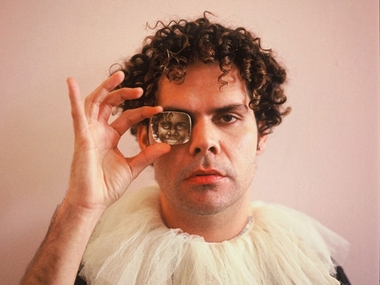INTERNATIONAL INDIGENOUS GATHERING IN WINNIPEG

Jonathan Jones Metis-inspired lightwork for Winnipeg
Posted by Jeremy Eccles | 31.01.11
Dates:
22.01.11
: 08.05.11
Location: Close Encounters Main Exhibition Site,109 Pacific Ave; Plug In Institute of Contemporary Art; The Winnipeg Art Gallery; Manitoba Museum; Manitoba Hydro Place; Urban Shaman;Platform Centre for photographic + digital arts; Gallery 1C03; La Maison des artist
One of the largest collections of Indigenous art ever assembled is being shown at galleries throughout Winnipeg in Canada. There are around 60 pieces of art included in Close Encounters: The Next 500 Years, created by 34 diverse artists. "Since the city was chosen as the Cultural Capital of Canada, they invited us to produce this exhibition," says Candice Hopkins, one of four curators who assembled the artwork for the show. "One of the reasons is because Winnipeg has one of the fastest growing urban aboriginal populations in Canada."
The world is changing, says the curatorial collective. Now is the moment to reconfigure our notions of time to reveal alternative ways of thinking and being for the future. In Close Encounters: The Next 500 Years , Indigenous artists imagine the future within the context of present experiences and past histories. By reconsidering encounter narratives between native and non-native people, Indigenous prophecies, possible utopias and apocalypses, this exhibition proposes intriguing possibilities for the next 500 years.
“We all in different measure have carved out the future,” observes Hopi photographer and filmmaker, Victor Masayesva, in his book Husk of Time. “We are all clairvoyants, soothsayers, prophets, knowingly assuming our predictions.”
Close Encounters brings together Indigenous artists from across Canada, the United States, South America, Europe, Australia and New Zealand, including newly commissioned work from Rebecca Belmore, Faye HeavyShield, Kent Monkman, and Jonathan Jones. Jones is one of three Blak artists from Australia; the others are Christian Bumburra Thompson and film-maker Tracey Moffatt. Lisa Reihana is the Maori rep.
Encounters today are less a “shock of the new” that defined first encounters in the early modern era; rather they are about possibilities of positive outcomes for the future. Jonathan Jones, for instance consulted with the Canadian Metis people and his work relates to their symbol, represented on their flag. Lisa Reihana interweaves Maori prophecies and mythologies with personal history and people into a Digital Marae where she connects her past with an imagined future. Jeffrey Gibson’s sculpture, Mythmaker is both a prophet and the guardian of future myths which embodies the choices made, and to be made, about the complex interrelationships between humans and the land. Choices and possibilities for the future are contained in Michael Belmore’s Smoulder - a hearth of carved stones and gold inlay. The work alludes both to an extinguished flame and the hope of regeneration through fire, the site of beginnings and ends.
Other works take on current colonial conditions. In a tongue-in-cheek gesture, Postcommodity's Repellent Eye consists of a custom-made 10 foot diameter “scare-eye balloon” looming over the city of Winnipeg. It replicates, on a much larger scale, balloons popular with environmentally-conscious gardeners to keep away annoying birds. The artists speculate that if a 16 inch diameter scare-eye balloon is effective in repelling pesky birds then perhaps something on a much larger scale might be effective in repelling Western civilization. In another meditation on end-times, Mary Anne Barkhouses's installation The Four Horses of the Apocalypse brings new perspective to the riders of pending doom. Here the nightmarish myth of the Book of Revelation is represented by four immaculately restored coin-operated toy horses - the kind of 60s era kiddie rides - outfitted in custom-made regalia. Each horse bears a different animal crest - bats and vultures; pelicans; a walrus and an oil drum; a wolf-creature carrying a chainsaw. Clearly it is the animals who have come back to wage war.
In a much darker mediation on the psychological hell brought about by assimilation policies and other symptoms of colonial encounters in Australia, Tracey Moffatt’s early experimental film Night Cries presents an Aboriginal woman trapped in the daily cycle of caring for her ailing adoptive mother. The final scene sees her overcome with grief, curled up beside her dead mother in a barren landscape where the only sound is of a baby's cry. In his most recent series of videos and stills, Heat 2010, Australia's third rep, Christian Thompson has again adopted the role of director to capture the affective experience of the desert climate in the Queensland outback. ''I love the mysticism and the seductive cruelty of the desert, my home, and how it can be so illusive and alluring and potentially life threatening", he said. However, the films were actually shot in the city where he lives using Hetti Perkins' daughters as actresses. “So, although my connection with the land is an inherent truth, what we are presented with is a fictitious incarnation”.
Works in multiple venues throughout the city will serve as catalysts to invent different ways of thinking, acting, and being in the world of our shared future. At this pivotal moment in time, Close Encounters invites engagement with the speculative, the prophetic, and the unknown. The future, of course, is the common theme running through show. Each piece is supposed to examine the unknown through past histories and present experiences."When choosing the theme, we also wanted to radically reverse people’s conception that Aboriginal art is stuck in the past," Hopkins says.
Curatorial Collective: Candice Hopkins, Steve Loft, Lee-Ann Martin and Jenny Western
Share this:
»  del.icio.us
»
del.icio.us
»  Digg it
»
Digg it
»  reddit
»
reddit
»  Google
»
Google
»  StumbleUpon
»
StumbleUpon
»  Technorati
»
Technorati
»  Facebook
Facebook
Contact Details

Christian Thompson's 'Hunting Ground'
Further Research
Artists: Archer Pechawis | Brett Graham | Brian Jungen | Christian Thompson | Colleen Cutschall | Doug Smarch Jr. | Edward Poitras | Faye HeavyShield | James Luna | Jeffrey Gibson | Jimmie Durham | Jonathan Jones | KC Adams | Kavavaow Mannomee | Kent Monkman | Linus Woods | Lisa Reihana | Maria Thereza Alves | Marie Watt | Marja Helander | Mary Anne Barkhouse | Michael Belmore | Paul-Anders Simma | Postcommodity | Pudlo Pudlat | Rebecca Belmore | Reuben Paterson | Rosalie Favell | Shuvinai Ashoona | Skawennati | Tracey Moffatt | Wally Dion | And Lawrence Paul Yuxweluptun
News Tags: Candice Hopkins | Close Encounters | Cultural Capital of Canada | Winnipeg
News Categories: Feature | Industry | North America
Exhibition Archive
- 10.10.17 | TARNANTHI 2017
- 11.08.17 | Natsiaas 2017
- 20.07.17 | APY ART DOMINATES THE WYNNE
- 17.07.17 | Anangu Artist Wins $100,000 Prize
- 14.07.17 | The End of AAMU
- 11.07.17 | ART ACROSS THE COUNTRY
- 11.07.17 | TARNANTHI IN OCTOBER
- 05.07.17 | TJUNGUṈUTJA - from having come together
- 13.06.17 | Ghost-Nets Straddle the World
- 07.06.17 | Grayson Perry Going Indigenous?
- 05.06.17 | Barks Bigger than Ben Hur
- 27.05.17 | NGA QUINQUENNIAL 2017
- 21.05.17 | Blak Douglas Finds Home at the NGA
- 21.05.17 | BRIAN ROBINSON WINS HAZELHURST WOP
- 18.05.17 | PARRTJIMA 2.0
Advertising

